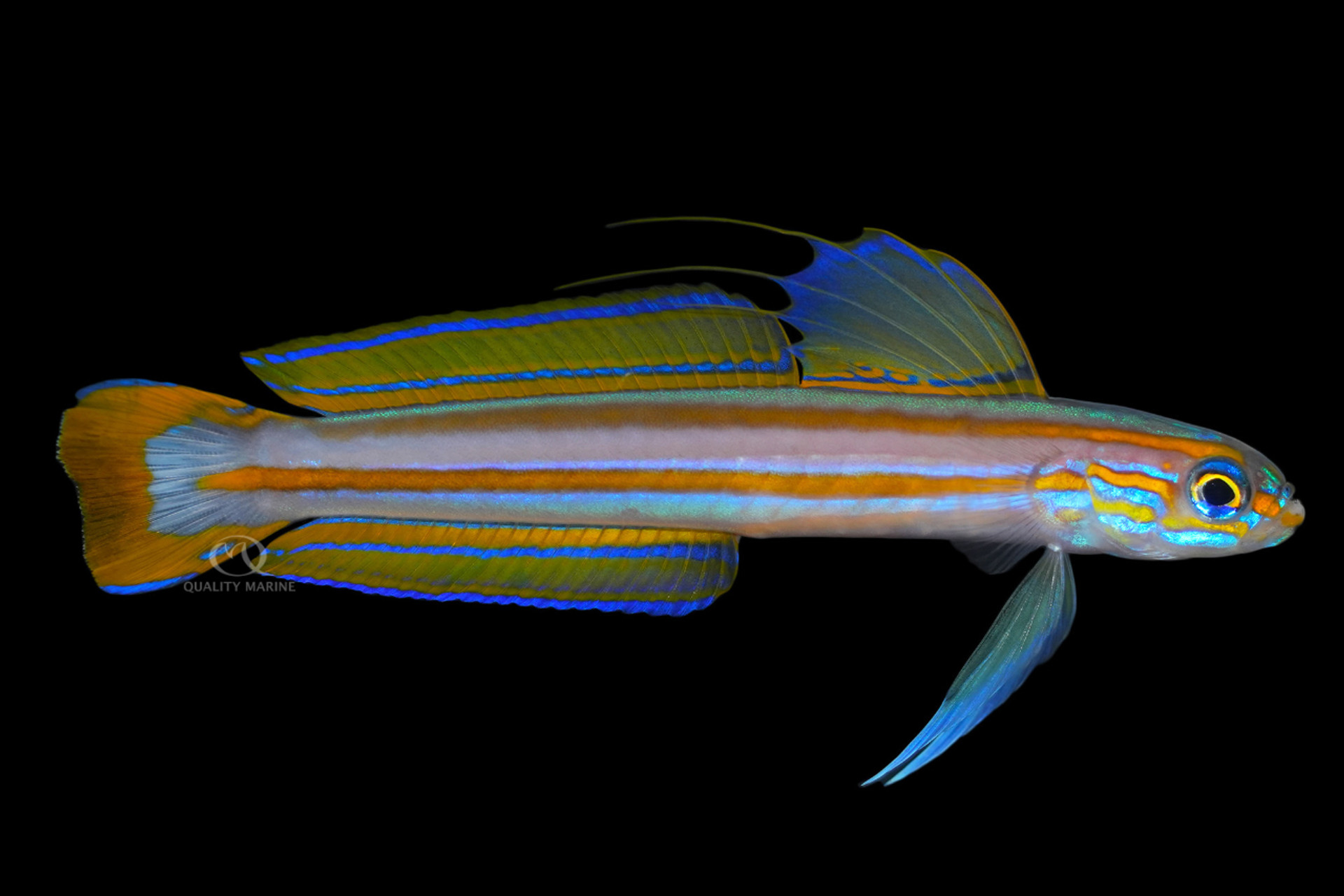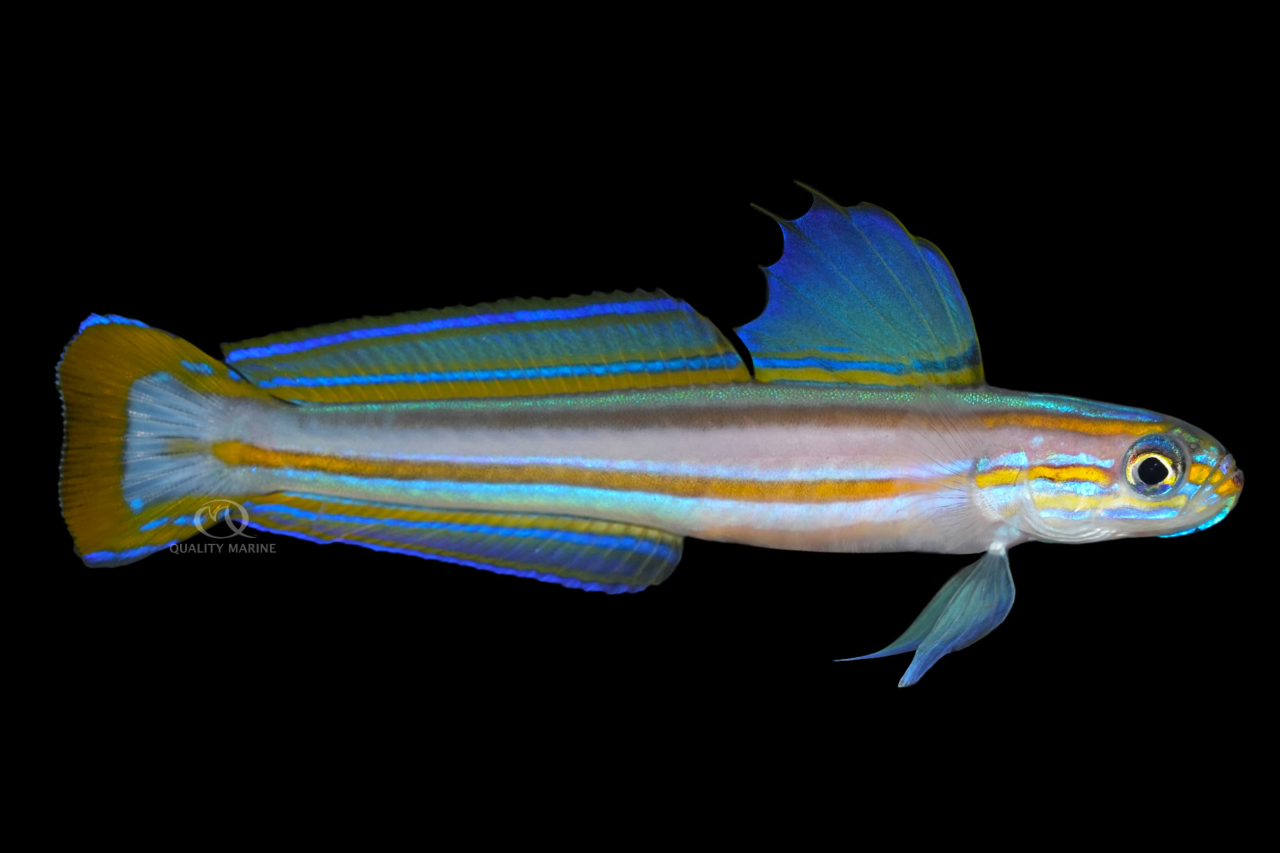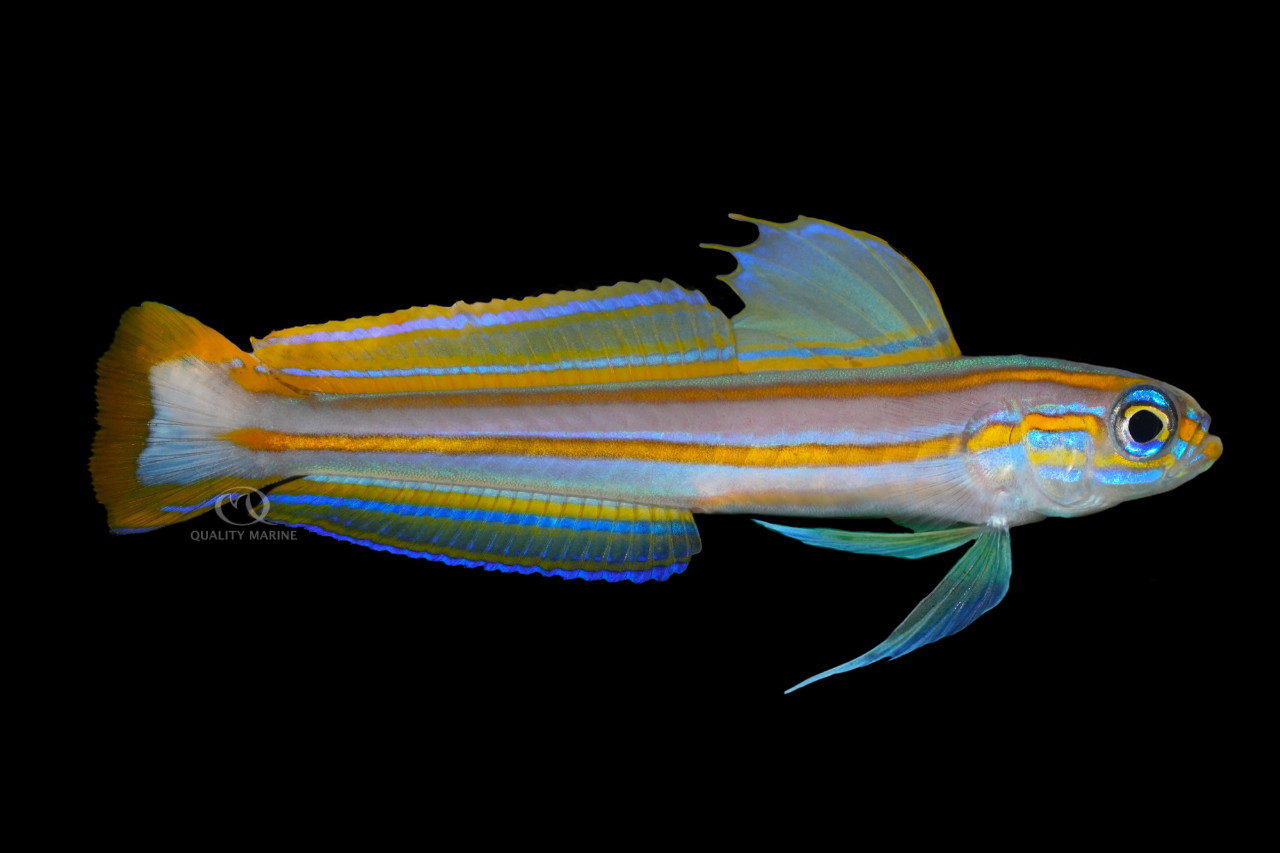More Dart Than Worm

Ptereleotris is a genus of fish whose species are peaceful (nearly too peaceful), unique in appearance and activity, well sized for aquariums and each are gorgeous in their own way. Perhaps the prettiest of them is the Ptereleotris grammica. Their iridescent blue bodies and sparkling gold lines are a statement in anyone's tank, and you combine this with the stunning fin shape and these fish are going to impress every person who passes by your aquarium.
Ptereleotris grammica is usually known by the common name “Lined Dartfish.” The whole genus is sometimes referred to as Wormfish, for really no good reason other than this fish's body shape is long and slender. We've seen them advertised as Many Striped Wormfish and maybe our favorite name, the Glorious Dart Goby.
 In the wild, these fish will congregate in large groups as juveniles but are only found as pairs or individuals as they reach adulthood. They can be kept singly, as pairs, or even in groups in the home aquarium. They have a wild range all over the tropical Western and Central Pacific as well as throughout the Indian Ocean, where they are usually collected in more than 100 feet of water. Their wild habitat is almost always the intersection of rock or rubble reefs and sandy areas. They hide and rest in burrows in the sand or holes in the rocks. Interestingly, they never make the burrows themselves, preferring instead to commandeer the homes that other fish or inverts have made. They don't form symbiotic relationships with any of these other animals, instead acting as one of the ocean's couch surfers, moving from spot to spot.
In the wild, these fish will congregate in large groups as juveniles but are only found as pairs or individuals as they reach adulthood. They can be kept singly, as pairs, or even in groups in the home aquarium. They have a wild range all over the tropical Western and Central Pacific as well as throughout the Indian Ocean, where they are usually collected in more than 100 feet of water. Their wild habitat is almost always the intersection of rock or rubble reefs and sandy areas. They hide and rest in burrows in the sand or holes in the rocks. Interestingly, they never make the burrows themselves, preferring instead to commandeer the homes that other fish or inverts have made. They don't form symbiotic relationships with any of these other animals, instead acting as one of the ocean's couch surfers, moving from spot to spot.
Lined Dartfish are the peace-loving beatniks of the tropical seas. Their timid nature is actually one of the most important parts of their husbandry. They can't be housed with large predator fishlike groupers or eels that will surely make a meal of them, but they also shouldn't be kept with fish that are aggressive or even overly active as this will scare them into hiding, making them nearly impossible to feed (and you'll never see them!) When picking other fish for this display, choose wisely. Some of our favorite Dartfish displays feature multiple dartfishes, even different species, which is almost never a problem, and is often a benefit as they become bolder in the aquarium with other similar fish. Other good choices are fishlike Cardinals, Dragonettes, small peaceful clownfish, Fairy Wrasses and some Gobies. Middle of the road choices could be Chromis, small Anthias and maybe Hawkfish or Blennies. Lined Dartfish are not a risk to corals or other invertebrates and make excellent additions to reef type displays.
In any aquarium, you should expect Lined Dartfish to be shy, especially initially as they become accustomed to your presence at the aquarium. As such, it is sometimes easier to get them to come out of hiding to eat if you feed them just as your lights come on and just after they go out. It is useful to have a nightlight in your display to help them find food during these times. Once they are used to having you around, you can move feeding times into daylight hours. When your Dartfish are acclimated, they will spend much of their day hovering in the water and will use quite a bit of energy to maintain this behavior so feeding at least twice a day is important. In house we feed them a mix of meaty foods, and Gamma Foods is always our product of choice. The daily mix changes but will include things like the full range of their Brine Plus products, as well as Rotifers, Large Copepods, Finely Chopped Prawn and Finely Chopped Mussel. In time, they will usually accept and do well on a high-quality sinking pellet like Nutramar Complete.
 Aquariums for Ptereleotris grammica needn't be overly large. They are a small fish, never getting much bigger than four inches long, and a pair of them could be easily kept in a tank that was 30 to 40 gallons. The display should feature rockwork that allows them a large number of hiding places. A mixed grain sand bed will look good, and if you have other critters like pistol shrimp that make burrows in it, the Lined Dartfish will take advantage of these burrows as well. Flow should be moderate to strong, in the range of 10-20 times the whole tank volume. The display should be covered and this is very important. Dartfish got their name from their primary defense mechanism; they dart into the nearest hiding spot so fast you barely see them move. If they do this in an upward direction, they'll end up on the floor every time unless the tank is covered.
Aquariums for Ptereleotris grammica needn't be overly large. They are a small fish, never getting much bigger than four inches long, and a pair of them could be easily kept in a tank that was 30 to 40 gallons. The display should feature rockwork that allows them a large number of hiding places. A mixed grain sand bed will look good, and if you have other critters like pistol shrimp that make burrows in it, the Lined Dartfish will take advantage of these burrows as well. Flow should be moderate to strong, in the range of 10-20 times the whole tank volume. The display should be covered and this is very important. Dartfish got their name from their primary defense mechanism; they dart into the nearest hiding spot so fast you barely see them move. If they do this in an upward direction, they'll end up on the floor every time unless the tank is covered.
The water chemistry and quality these fish need is very standard. They aren't that picky about specific gravity, and anything between 1.021 and 1.026 will be fine as long as it is stable. Maintain pH between 8.0 and 8.4. Strive to keep nitrates below five ppm, which will require regular water changes, which will also help keep the pH stable. Water temperature should live in normal tropical ranges, somewhere between 70 and 78.
Ptereleotris grammica is a gorgeous fish, and one of the rarer Dartfish you'll come across. Once acclimated they're an amazing display animal and a perfect addition or any reef or fish only tank that features other peaceful critters. It's difficult to find this kind of star power in a fish this small, but if sheer beauty combined with great activity is what you're looking for, a couple Lined Dartfish could be just the ticket. Ask your LFS about getting you some sustainably sourced ones from Quality Marine today!